
Dinner Party from a Toothpaste Ad, Delineator magazine, January, 1924. These full hairdos were about to be replaced by “slicker” head-hugging styles.
I’m not a big fan of Downton Abbey, but I watch it anyway. In the last episode I saw, in season 5, Lady Mary got a new haircut, which is certainly something lots of women do when they feel the need for a change. But there was something about her bob that bothered me, so I poked around in my files, trying to figure out what it was.
Instead, I found a lengthy article about bobbed hair, “Slicker ‘n’ Slicker,” from January 1925, plus many hair-related images. The article is long, so I’ll break the text up into readable sections (over two posts) and include period images of the styles it refers to. The author, Celia Caroline Cole, was a regular beauty columnist for Delineator magazine, and most of my images are from mid-twenties issues of Delineator.
Here is the illustration and caption that accompanied “Slicker ‘n’ Slicker”:

“One’s crowning glory is such a problem, what is a body to do? To bob or not to bob — and how?” Delineator, Jan. 1925, p. 22.
“ONE-FOURTH of the women of Paris are bobbed. And there is about that same proportion in London and New York.” — Celia Caroline Cole, Delineator, January 1925.
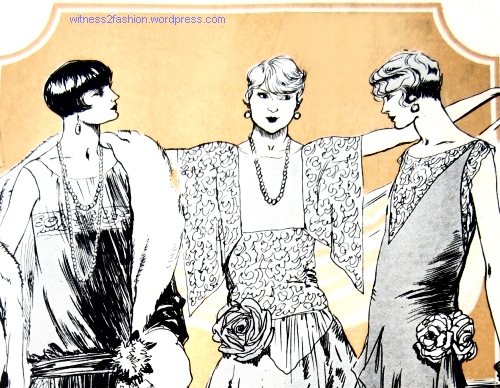
Paris fashions from Lucien Lelong, left, and Jean Patou, center and right. The models have bobbed and shingled hair. Sketched by Soulie for Delineator, late 1925.
Women Whose Hair Was Not Yet Bobbed
What about the other seventy-five percent of women, the ones who had not yet succumbed to the fashion for very short, “slick” hair?
Bobbed hair had first been popularized during World War I; dancer and fashion icon Irene (Mrs. Vernon) Castle was influential in setting the style.

Irene Castle, with bobbed hair, endorsing Corticelli Silk in this advertisement from Ladies’ Home Journal, October 1917.
However, after the war ended, long hair became fashionable again. The Marcel Wave — and later, a permanent curl — made it possible for women born with straight hair to have very wavy locks. You could even get a home permanent “outfit” (using one roller, which screwed into your lamp, like a lightbulb, since there was usually no other electrical supply in the room.) “A whole head can be waved comfortably in just a few hours.”

A Nestle Home Permanent Outfit, “Price only $15” in December, 1924. Delineator. It’s going to take more than a few hours to wave that head of hair.
My mother, like many other women, was still wearing her “marcelled” hair in the late 1920s:
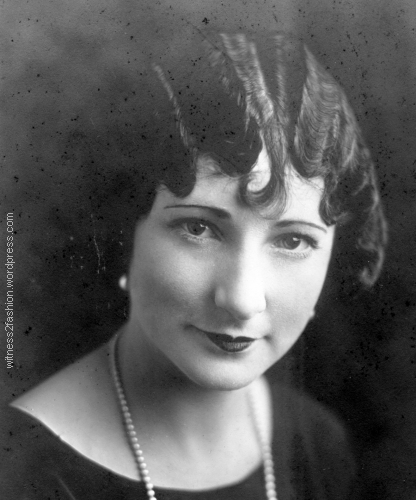
A marcel wave, worn close to the head to fit under a cloche hat in the 1920’s. Most women did not wear a curl right in the middle of their foreheads, but her center part was very typical. “A part in the middle is as smart for bobs as for long hair.”
Three models from one page of Delineator magazine, November 1924: the woman on the left has a marcel wave and long hair gathered into a chignon low on her neck. The woman on the right has a sleek bob with a “shingle” cut in back. Either style would fit under a cloche hat.
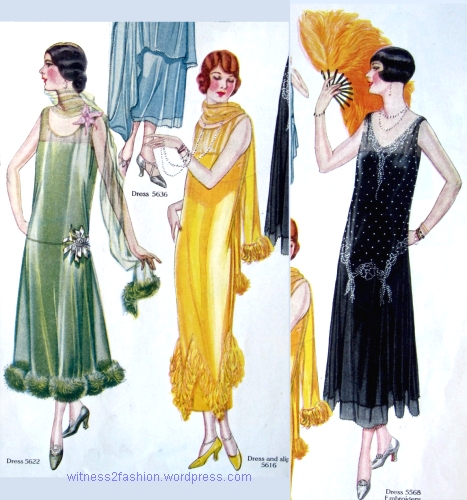
November 1924: Three hair styles seen together in one Butterick pattern illustration. Delineator, p. 27.
Return of the Bob
The fashion for bobbed hair returned in the early 1920’s. Daring young women went to the local (male) barber shop to have their “crowning glory” chopped off — sometimes to the horror of their parents.

Barber’s Display card sold to barber shops in 1924. From An Illustrated History of Hairstyles, by Marian I. Doyle, page 82.
However, in January of 1925, most women had not yet bobbed their hair. Those who had, usually wore it very full (one might say, “bushy”); the author of “Slicker ‘n’ Slicker” refers to their “large, gnomelike heads.” Ads for shampoos and other hair products emphasized a thick, wavy head of hair:

An ad for Danderine hair product, January 1925. Delineator. In the same issue, the beauty editor called these bobbed hairdos “very demodee.”
Even these styles, from the Barber Shop display card shown above, are full, rather than sleek.
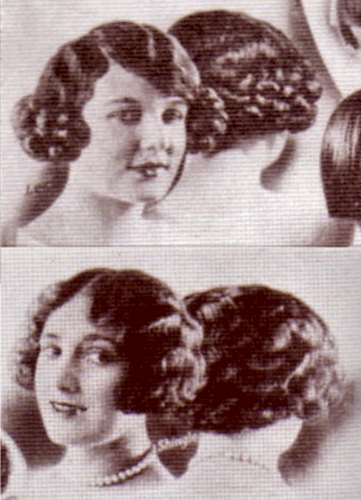
Straight bobs from barber shop display card, 1924. From An Illustrated History of Hairstyles, M. Doyle.
That is why the beauty editor of Delineator had to tell women, in January of 1925, that “the old straight bob is very demodee.” [Démodée means “out of style, unfashionable.”] “To be modee and exciting and to look like an illustration in a novel, the hair should be either shingled or dressed so close to the head that it looks like paint.” — C. C. Cole
The Shingle Explained
“If a woman has a well-shaped head . . . , the hair is cut close to the head in the back and about a third of the way up from the nape of the neck and from there on it is longer. The whole aim is to have a beautiful line for the back of the head — that loveliness one finds in the head of a young boy.
“If the hair is thin . . . , the smart hairdresser does not cut the hair close at the nape of the neck, but cuts it in one length from the crown to the nape, thinning the ends with a razor so that it will not stand out.” — Celia Cole in her article “Slicker ‘n’ Slicker.”
More Exerpts from “Slicker ‘n’ Slicker,” Published in January 1925

“A dashing little head on the top of a slender supple body not at all concealed by its extremely simple frock.” Pattern illustrations from Delineator, Feb. 1924.

Four Paris models sketched by Soulie, Delineator, January 1925 — The same issue carried “Slicker ‘n’ Slicker.”

“The short, stout woman can very rarely wear a shingle; she needs a ‘thatch.’ ” Round-U Corset ad, Dec 1924. Delineator.
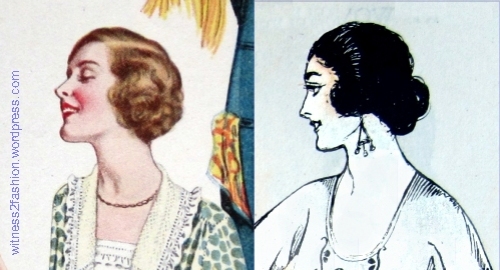
“Wave it” or “Dress it low” if a shingle doesn’t suit your hair or head shape; two styles from 1924. Delineator.
However, if a woman’s hair is thick, she should “go to a good barber — and by “barber” we mean a woman’s barber, a hairdresser — and have him thin it out evenly, so that it can be dressed smartly close.”
To be continued . . . .


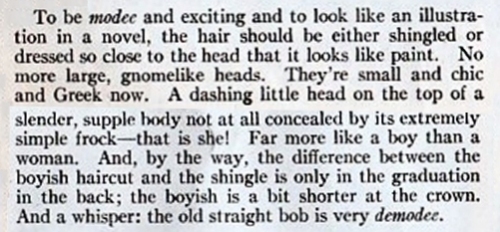


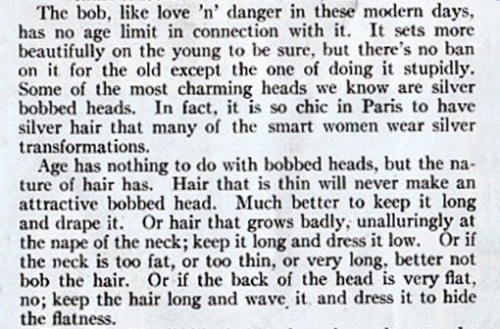
And if she’s short and stout and older and has a massive head of gorgeous curls, as both my grandmas did who were 34 in 1925, I shudder to think what she would up if she followed these ads! I thought Mary’s haircut looked beautiful, but I never particularly liked her in the 1918 hairdo, coiled at the nape of her neck, because it was obvious her hair is so thin and straight, despite the braids and switches they added. And I think its hard for very dark hair to show up the waves the way, say Edith’s hair does, or the Dowager Countess. And I think they do a very nice realistic job with the downstairs staff, even if it does obscure Penelope Wilton’s lovely forehead and eyes at times!
Yes, I’m glad not everyone is a slave to whatever passing fancy magazine editors are pushing. Even this article gets around to saying that a large woman needs more hair to balance her looks. Were you lucky enought to inherit your grandmas’ natural curls?
Well, I don’t think I have ever seen the boyish aesthetic of twenties fashion stated so clearly–“the loveliness one finds in the head of a young boy.” But I’m still a little confused. I thought to “bob” ones hair just meant to cut it short. Hadn’t your mother, with her marcelled curls, bobbed her hair? (What a beauty, by the way.)
Judging from the pictures, etc., the initial “straight bob” was not tapered or shaped, and tended to widen out at the bottom if curly. Clara Bow’s hair often was a messy frizz around her face. Initially, women got their bob at the barber shop — previously an all-male preserve; some barbers put a display card in the window to let women know they would not be thrown out. Others didn’t want their smoke-filled “boys’ club” atmosphere disturbed.
The Delineator’s beauty editor was trying to introduce the kind of carefully shaped haircut you would get from a hairdresser/barber instead of a man’s barber. (Maybe that part of her article is in the next post!)
My mother and her best friend were the first girls in town to get their hair cut, in the very early 1920s — without their parent’s permission. But soon her hair had grown long enough to wear it in a chignon low on her neck (you can’t see that in the photo) and she had very long hair during the 1930s and 1940s, although she wore it “up”.
I think that we don’t recognize the social, moral and political impacts of bobbing the hair today. Up to the 1920s men and women dressed and cut their hair in very different ways. You could tell a man from a woman at 200 paces. Suddenly, girls started to upset the old order, short skirts, smoking, immoral dances and – horror of horrors – short hair – just like a boy.
There are all sorts of theories about bobs – making a statement of defiance, making a statement about voting, looking like a man to make up for the loss of eligible husbands in the carnage of WW1.
All these changes in female dress and behavior caused enormous shocks for those people raised and educated in the 19 century Victorian age.
Dinah
About the only equivalent shock to parents I can think of is body piercing and/or tattoos in the 1980s/1990s, and those are now so common that they have no shock value in my city. (I’m not speaking as a parent.)
Yes, I know what you mean, but I think bobbing was more of an affront to the “old order”.
I think of it as a circle – women live in this circle. Men and older women might not like the fashions worn IN the circle – mini skirts, piercings, cloche hats even, but it was still in the circle. With bobbed hair women were seen to be stepping out of the circle – they looked like men, no or lighter corsets – therefore not the old “corset posture”, and they wanted to vote. These things were seen as a direct threat to the established old order (when everyone had their place and you knew where you were!) .
It must have been (and was!) very upsetting for the older “respectable” generation. After all “papa knows best” was the manner in which girls up to marriage were expected to live by – until WW1.
Dinah
You’re right: there is a difference between a threat to parental authority and a threat to male authority and privilege. How lucky I am to live in the (still imperfect) western world: I have never been excluded from higher education or the right to work or the right to own property or the right to vote. In the 1920s these were still relatively new ideas — some of them newer than others.
Thank you for your comment! Just by way of a little example years ago I interviewed a lady who was a teenager during WW1. She had a younger brother who she “mothered” and loved it. When they were both teenagers their mother heard them arguing. The mother drew the daughter aside and said “he’s a man now, you must let him know best”. Naturally the elder sister was VERY angry – she wanted a more equal world.
The liberation of women through fashion had been evolving in society well before the bob and I see the shorter hairstyles as a continuation of the acceptance of the changing roles of women. The role that advertising, literature and the arts played in popularising the new fashion for short hair shouldn’t be underestimated.
Yes, indeed, Christina! The liberation of women really started in the second half of the 19 C. The UK Women’s Property Act 1882 was a landmark victory. Until that date women did not have their own personal possessions – it all belonged to the boss – the man. The woman was a “feme covert” (sic) – she did not really exist on her own. This did give SOME protection to women – they could not be sued in court – you had to go after the husband. Then came the Suffragettes, and most importantly WW1. During this time fashions started to get a little more practical. Perhaps not formal dinner dresses, but cycling dresses, tennis dresses and tango corsets started to appear.
In the UK women showed that they could do the necessary work during WW1 in factories and the fields NEARLY as well as men. But of course no real man would say “as well as!
Another titbit that shows how people thought in the early part of the 20 Century. Women doctors started to appear – and it was NATURALLY assumed that their patients would be women and children. After all, no self respecting man could talk about personal things to a simple woman.
Dinah
In the twentieth century there is reference to a bob being seen in 1915 in North America (Smithsonian ref). I wonder where that puts Joan of Arc or very early images depicting women with short hair? In Asia women followed the trend and made political statements by doing so although in Japan for example and I am just reading about this, some women “modern girls” or moga saw the bob as purely a fashion trend.
Hello Christina
My grandson who is an expert on medieval warfare says that soldiers had short hair so that it all went under the helmet and left no wisps that an enemy might use to drag the other to the ground. Joan of Arc was dressed as a soldier (one of her “crimes” was trying to pass as a man) and therefore had short hair. Later on, my grandson says (!) some kings had portraits painted with long hair to show that they were not soldiers.
You reference to bobbing in 1915 is interesting – these things take a time to get established from the first to “common place”. As discussed earlier I believe bobbing was much more than simply a new hair style – it was a message of defiance – which is why it caused so much fuss —and why this blog is so interesting – thank W2F!
Dinah
World War I was experienced much differently in England and the rest of Europe than in the U.S., of course, since there were no battlefields in America, and the U.S. entered the war in April of 1917, almost two years after it began. After England went to war in August of 1914, English women working in munitions factories and other occupations involving machinery were encouraged to cut their long hair shorter for safety reasons. (“Bob” as in “bobcat” or “bobtail” was a slangy way of saying “cut” or “cut short”.)
Pingback: To Bob or Not to Bob Your Hair: 1925 (Part 2) | witness2fashion
Pingback: Permanents and Marcels Bridge the Twenties to Thirties | witness2fashion
Pingback: How to Marcel: Video | witness2fashion